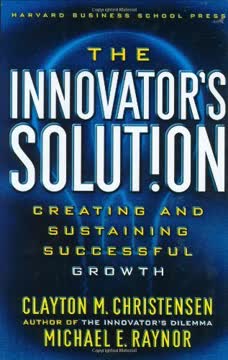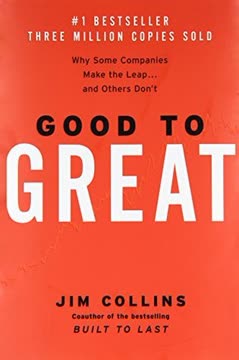Key Takeaways
1. The Business Model Canvas: A Visual Tool for Describing, Analyzing, and Designing Business Models
"The Business Model Canvas is like a blueprint for a strategy to be implemented through organizational structures, processes, and systems."
Visualize your business model. The Business Model Canvas is a shared language for describing, visualizing, assessing, and changing business models. It's a one-page visual tool divided into nine building blocks that cover the four main areas of a business: customers, offer, infrastructure, and financial viability.
Facilitate collaborative design. The Canvas works best when printed out on a large surface so groups can jointly sketch and discuss business model elements using sticky notes or markers. This hands-on approach fosters understanding, creativity, and analysis among team members.
Example: Apple iPod/iTunes. Apple's innovative business model combined the iPod device, iTunes software, and online store to create a seamless music experience. This potent combination disrupted the music industry and gave Apple a dominant market position, demonstrating the power of a well-designed business model.
2. Nine Building Blocks: Key Components of Every Business Model
"A business model describes the rationale of how an organization creates, delivers, and captures value."
Essential elements. The nine building blocks of the Business Model Canvas are:
- Customer Segments: Who are we creating value for?
- Value Propositions: What value do we deliver to customers?
- Channels: How do we reach our customers?
- Customer Relationships: What type of relationship do we establish?
- Revenue Streams: How do we generate income?
- Key Resources: What assets are required?
- Key Activities: What activities do we need to perform?
- Key Partnerships: Who are our key partners and suppliers?
- Cost Structure: What are the most important costs?
Interconnected components. These building blocks form a cohesive system where changes in one area often affect others. Understanding these relationships is crucial for designing effective business models.
3. Business Model Patterns: Common Configurations That Create and Capture Value
"Pattern in architecture is the idea of capturing architectural design ideas as archetypal and reusable descriptions."
Recognizable models. Business model patterns are common arrangements of building blocks with similar characteristics or behaviors. Five key patterns are:
- Unbundling
- The Long Tail
- Multi-Sided Platforms
- FREE as a Business Model
- Open Business Models
Learn from success. Studying these patterns can help you understand business model dynamics and inspire your own innovations. For example, the "Long Tail" pattern focuses on selling a large number of niche products, each in small quantities, as exemplified by Amazon's vast product catalog.
Combine and adapt. A single business model can incorporate multiple patterns. The challenge is to adapt these patterns to your specific context and create unique value propositions.
4. Customer Insights: The Foundation of Successful Business Models
"Ultimately, business model innovation is about creating value, for companies, customers, and society."
Understand customer needs. Successful innovation requires a deep understanding of customers, including their environment, daily routines, concerns, and aspirations. This insight should inform choices regarding Value Propositions, Channels, Customer Relationships, and Revenue Streams.
Look beyond the obvious. Sometimes, tomorrow's growth segments wait at the periphery of today's core business. Avoid focusing exclusively on existing Customer Segments and set your sights on new or unreached segments.
Use empathy mapping. The Empathy Map tool helps you go beyond demographic characteristics to develop a better understanding of environment, behavior, concerns, and aspirations. This allows you to devise stronger business models that truly resonate with customers.
5. Ideation: Generating Innovative Business Model Ideas
"Business model innovation is not about looking back, because the past indicates little about what is possible in terms of future business models."
Challenge assumptions. To generate truly new ideas, it's crucial to ignore the status quo and suspend concerns over operational issues. Question industry orthodoxies and explore new mechanisms to create value and derive revenues.
Use multiple starting points. Ideas for business model innovation can come from anywhere. Consider four epicenters of business model innovation:
- Resource-driven
- Offer-driven
- Customer-driven
- Finance-driven
Embrace "What if" questions. These provocative queries help break free of constraints imposed by current models. For example: "What if furniture buyers picked up components in flat pack form from a large warehouse and assembled the products themselves in their homes?" This "what if" scenario led to IKEA's revolutionary business model.
6. Visual Thinking: Making Business Models Tangible and Understandable
"Because business models are complex concepts composed of various building blocks and their interrelationships, it is difficult to truly understand a model without sketching it out."
Power of visualization. Visual thinking is indispensable to working with business models. Using visual tools like pictures, sketches, diagrams, and sticky notes helps construct and discuss meaning, making abstract concepts tangible and facilitating co-creation.
Enhance communication. Visual representations of business models can:
- Create company-wide understanding
- Improve internal "selling" of ideas
- Enhance external pitches to investors or partners
Techniques to try:
- Use sticky notes for flexibility in arranging ideas
- Sketch simple drawings to convey concepts quickly
- Create a visual story to explain your business model step-by-step
7. Prototyping: Exploring and Testing Business Model Possibilities
"Prototyping is a powerful tool for developing new, innovative business models."
Beyond physical products. In business model design, prototypes can take various forms:
- A simple sketch
- A fully thought-through concept described with the Business Model Canvas
- A spreadsheet simulating the financial workings of a new business
Tool for inquiry. Prototypes serve as thinking aids for exploring new possibilities, not just representations of to-be-implemented models. Making and manipulating prototypes forces us to address issues of structure, relationship, and logic in ways unavailable through mere thought and discussion.
Embrace iteration. Develop multiple prototypes at different levels of refinement. This process of exploration and refinement is most likely to yield the best alternatives. Avoid falling in love with ideas too early; take time to explore multiple options before selecting one to implement.
8. Storytelling: Communicating the Essence of a Business Model
"Storytelling is an undervalued and underused art in the world of business."
Power of narrative. Stories engage listeners and help overcome resistance to unfamiliar or innovative business models. A good story can win attention and make abstract concepts tangible and relatable.
Multiple applications. Storytelling can be effective for:
- Introducing new business model ideas within an organization
- Pitching to investors or potential shareholders
- Engaging employees during business model transitions
- Clarifying complex ideas and facilitating in-depth discussions
Techniques for effective storytelling:
- Use a single protagonist (e.g., a customer or employee)
- Focus on how your business model solves real problems
- Incorporate emotion and drama to make the story memorable
- Consider using visual aids like drawings or storyboards
9. Strategy Through the Business Model Lens: Evaluating and Adapting to the Environment
"A competitive business model that makes sense in today's environment might be outdated or even obsolete tomorrow."
Continuous assessment. Regularly evaluating your business model is crucial in today's rapidly changing business environment. This helps detect potential problems early and identify opportunities for innovation or adaptation.
External forces to consider:
- Market forces (e.g., customer needs, market segments)
- Industry forces (e.g., competitors, new entrants, substitutes)
- Key trends (e.g., technology, regulatory, societal)
- Macroeconomic forces (e.g., global market conditions, economic infrastructure)
SWOT analysis. Combine classic strengths, weaknesses, opportunities, and threats (SWOT) analysis with the Business Model Canvas to assess each building block in detail. This structured approach can reveal paths to innovation and renewal.
10. Managing Multiple Business Models: Balancing Innovation and Existing Operations
"Implementing a new business model in a longstanding enterprise can be extraordinarily difficult because the new model may challenge or even compete with established models."
Ambidextrous organizations. Successful companies must often manage new business models while maintaining existing ones. This requires balancing innovation with current operations, a challenge known as organizational ambidexterity.
Integration vs. separation. When implementing a new business model, consider:
- Severity of conflict between old and new models
- Strategic similarity
- Risk of negative impact on the established model
Options for implementation:
- Full integration into existing organization
- Partial integration (e.g., shared resources)
- Complete separation as a standalone entity
- Phased approach (e.g., initial separation followed by later integration)
11. The Business Model Design Process: From Concept to Implementation
"Business model innovation rarely happens by coincidence. But neither is it the exclusive domain of the creative business genius. It is something that can be managed, structured into processes, and used to leverage the creative potential of an entire organization."
Five phases of business model design:
-
Mobilize: Prepare for a successful project
- Frame objectives, assemble team, plan initial activities
-
Understand: Research and analyze necessary elements
- Scan environment, study customers, interview experts
-
Design: Generate and test viable options
- Brainstorm, prototype, select best model
-
Implement: Execute the chosen model
- Communicate, manage projects, adapt quickly
-
Manage: Continuously assess and evolve
- Monitor environment, rejuvenate or rethink model as needed
Design attitude. Embrace a mindset that values exploration and prototyping over immediate decision-making. This approach, while messier and less linear than traditional business planning, is more likely to yield powerful new business models.
Established company considerations:
- Build project legitimacy and manage vested interests
- Create cross-functional teams for diverse perspectives
- Balance bold ideas with organizational realities
- Maintain a long-term focus when evaluating new models
Last updated:
FAQ
What's "Business Model Generation" about?
- Comprehensive Guide: "Business Model Generation" by Alexander Osterwalder is a comprehensive guide to understanding, designing, and implementing innovative business models.
- Visual Framework: It introduces the Business Model Canvas, a visual framework for describing, analyzing, and designing business models.
- Collaborative Approach: The book emphasizes a collaborative approach, involving various stakeholders in the business model design process.
- Practical Tools: It provides practical tools and techniques for business model innovation, making it accessible to entrepreneurs, executives, and consultants.
Why should I read "Business Model Generation"?
- Innovative Thinking: The book encourages innovative thinking and challenges traditional business models, making it essential for anyone looking to stay competitive.
- Practical Application: It offers practical tools and techniques that can be immediately applied to real-world business challenges.
- Visual and Engaging: The visual format and engaging content make complex concepts easy to understand and apply.
- Broad Audience: It's suitable for a wide audience, including entrepreneurs, executives, consultants, and academics interested in business model innovation.
What is the Business Model Canvas?
- Visual Tool: The Business Model Canvas is a strategic management tool that provides a visual framework for developing new or documenting existing business models.
- Nine Building Blocks: It consists of nine building blocks that cover the four main areas of a business: customers, offer, infrastructure, and financial viability.
- Shared Language: It creates a shared language for describing, visualizing, assessing, and changing business models.
- Practical Application: The Canvas is used by leading organizations worldwide to innovate and improve their business models.
What are the key takeaways of "Business Model Generation"?
- Business Model Innovation: The book emphasizes the importance of innovating business models to stay competitive in a rapidly changing market.
- Collaborative Design: It highlights the value of involving diverse teams in the business model design process to generate creative solutions.
- Visual Thinking: The use of visual tools like the Business Model Canvas can simplify complex concepts and foster better communication.
- Continuous Adaptation: Businesses must continuously adapt their models in response to environmental changes and emerging opportunities.
How does the book define a business model?
- Value Creation: A business model describes the rationale of how an organization creates, delivers, and captures value.
- Nine Building Blocks: It is best described through nine basic building blocks that show the logic of how a company intends to make money.
- Blueprint for Strategy: The business model acts as a blueprint for implementing strategy through organizational structures, processes, and systems.
- Dynamic and Evolving: Business models are dynamic and must evolve in response to changes in the environment and market demands.
What are the nine building blocks of the Business Model Canvas?
- Customer Segments: Defines the different groups of people or organizations an enterprise aims to reach and serve.
- Value Propositions: Describes the bundle of products and services that create value for a specific Customer Segment.
- Channels: Outlines how a company communicates with and reaches its Customer Segments to deliver a Value Proposition.
- Customer Relationships: Describes the types of relationships a company establishes with specific Customer Segments.
- Revenue Streams: Represents the cash a company generates from each Customer Segment.
- Key Resources: Describes the most important assets required to make a business model work.
- Key Activities: Outlines the most important things a company must do to make its business model work.
- Key Partnerships: Describes the network of suppliers and partners that make the business model work.
- Cost Structure: Describes all costs incurred to operate a business model.
What are some business model patterns discussed in the book?
- Unbundling Business Models: Separating infrastructure management, product innovation, and customer relationships into distinct entities.
- The Long Tail: Focusing on offering a large number of niche products, each of which sells relatively infrequently.
- Multi-Sided Platforms: Bringing together two or more distinct but interdependent groups of customers.
- FREE as a Business Model: Offering a substantial Customer Segment a free-of-charge offer, subsidized by another part of the business model.
- Open Business Models: Collaborating with outside partners to create and capture value.
How does "Business Model Generation" approach business model design?
- Customer Insights: Understanding customers deeply to inform business model design choices.
- Ideation: Generating a large number of business model ideas and isolating the best ones.
- Visual Thinking: Using visual tools like sketches and diagrams to construct and discuss business models.
- Prototyping: Creating prototypes of business models to explore different possibilities and refine ideas.
What is the role of storytelling in business model innovation?
- Engagement: Storytelling helps engage stakeholders by making new business models more tangible and relatable.
- Communication: It is a powerful tool for explaining complex business models in a simple and compelling way.
- Overcoming Resistance: Stories can help overcome resistance to change by illustrating the benefits and potential of new models.
- Clarification: They clarify how a business model creates value and how it fits into the broader market context.
How does the book suggest evaluating business models?
- SWOT Analysis: Combining SWOT analysis with the Business Model Canvas to assess strengths, weaknesses, opportunities, and threats.
- Big Picture Assessment: Evaluating the overall integrity of a business model and its components.
- Environmental Scanning: Understanding the external forces that influence a business model and how they might evolve.
- Continuous Adaptation: Regularly assessing and adapting the business model in response to market changes and feedback.
What is the Blue Ocean Strategy and how does it relate to business models?
- Value Innovation: Blue Ocean Strategy focuses on creating new market space through value innovation, increasing value while reducing costs.
- Four Actions Framework: It involves eliminating, reducing, raising, and creating factors to differentiate from competitors.
- Business Model Canvas Integration: The Canvas helps visualize how changes in value creation impact other business model components.
- Exploring New Markets: It encourages exploring non-customer groups to create uncontested market space.
What are the best quotes from "Business Model Generation" and what do they mean?
- "Businesspeople don’t just need to understand designers better; they need to become designers." This quote emphasizes the importance of adopting a design mindset in business model innovation.
- "There’s not a single business model... There are really a lot of opportunities and a lot of options and we just have to discover all of them." It highlights the diversity of business models and the need for exploration and discovery.
- "The demand you get at a price of zero is many times higher than the demand you get at a very low price." This underscores the power of free offers in attracting large customer bases.
- "If you freeze an idea too quickly, you fall in love with it." It warns against prematurely committing to a single idea without exploring alternatives.
Review Summary
Business Model Generation receives mostly positive reviews for its innovative approach to business planning using the Business Model Canvas tool. Readers praise its visual style, practical examples, and actionable frameworks for developing business models. Many find it valuable for entrepreneurs and established companies alike. Some criticize the writing as dry or repetitive in parts. Overall, reviewers recommend it as an essential resource for understanding and creating effective business models, though a few feel it oversimplifies complex business concepts.
Similar Books










Download PDF
Download EPUB
.epub digital book format is ideal for reading ebooks on phones, tablets, and e-readers.






